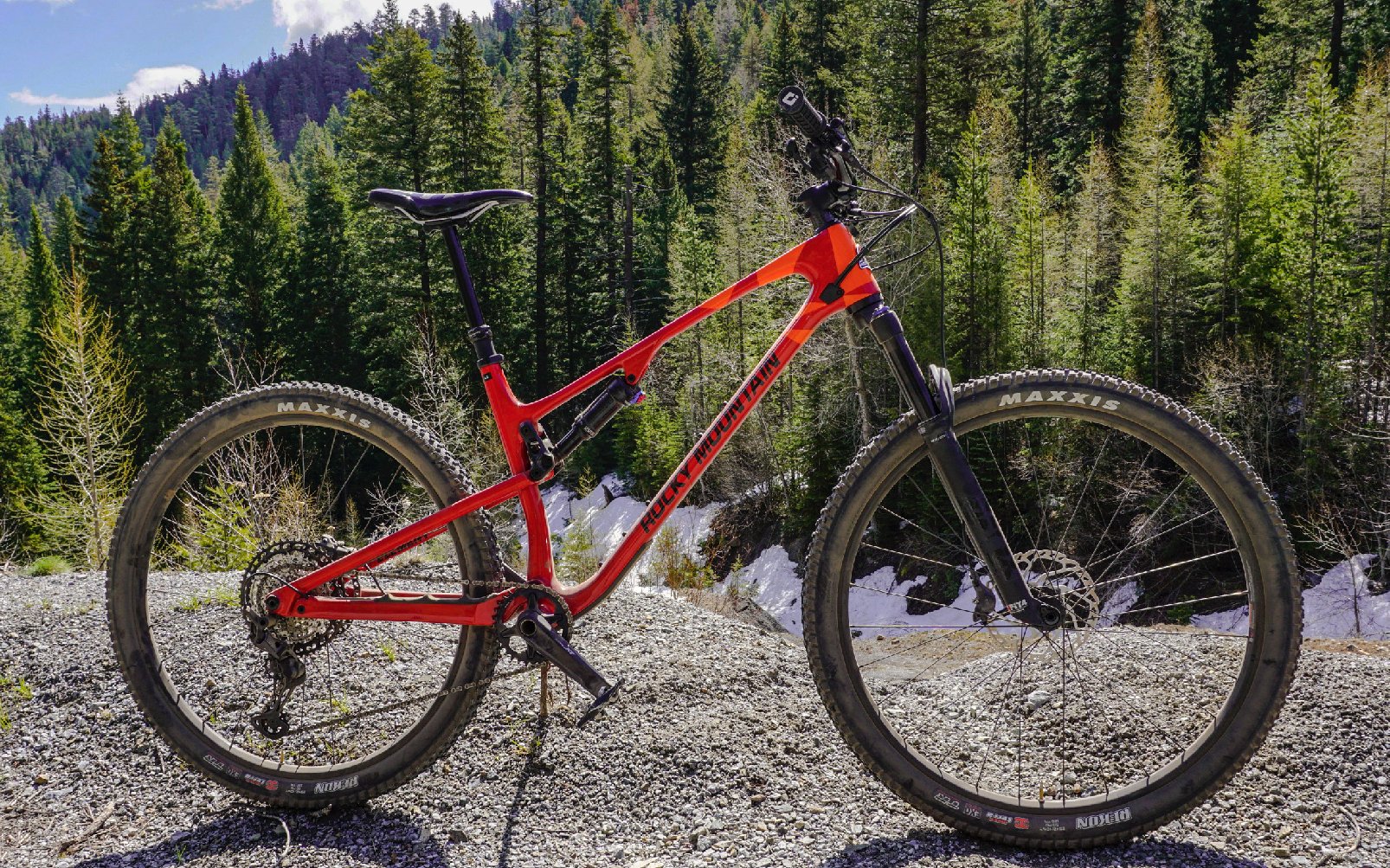
First Impressions REVIEW
2022 Rocky Mountain Element Carbon 70
The Slackening: Rocky Mountain's Element stretches the definition of XC
Rocky Mountain Element Carbon 70
$6819 USD | 7,879.00 CAD
XC has traditionally been a weight game, with priority given to reduction of mass over ride quality, traction, or comfort. As such, it might, at times, have seemed as if XC bike design has lagged a bit behind the rest of mountain biking’s diverse families. Nowhere has this been more evident than with geometry. The rest of mountain biking has been angling toward slacker head angles, steeper seat angles and longer wheelbases for a decade or so now. Over in XC land frame numbers have for the longest time remained short and sharp, and only in the past few years has the XC world seen some cautious implementation of the new long’n’slack paradigm.
Rocky Mountain, however, has picked up the long’n’slack zeitgeist and run with it. The large size Element Carbon 70 bike you see here has a 65-degree head angle, a 76-degree seat angle, 120mm of rear travel, 483mm of reach, and a 1231mm wheelbase (in size L). Twelve Hundred and Thirty One Millimeters. That is long. How Long? Well, by comparison, it’s 52mm longer than the wheelbase of a Specialized Epic, and 56mm longer than a Cannondale Scalpel. The ultra-traditional and barely suspended Trek Supercaliber gives up a whopping 95mm of wheelbase to the rangy Rocky.
“Ahhh, but…” I hear you say, “this Element is a 120mm bike. That’s not really XC.”
Okay, fine, I’ll grant you that it’s a bit more leggy than most dedicated XC race whips. But this IS what Rocky is positioning as its XC racebike. And Rocky’s not the only brand following this path. Going like-for-like and calling up other 120mm XC bikes like the Kona Hei Hei CR/DL (1185mm wheelbase), or the Transition Spur (1219mm wheelbase), the Element still outstretches them all. It’s the slackest, longest interpretation of XC yet. To put it in another perspective, this Element is a little under an inch shorter between the wheels than a Transition Sentinel, which most would agree is a pretty damn long bike. Or, just for the sake of weirdness, it’s a degree steeper and a full 14mm longer than a 2018 Santa Cruz V10.
So, is this XC? While it could be assumed that going longer and slacker will make for a better trail bike, does it translate to modern XC race worthiness? What are the trade-offs encountered when painting a narrow niche with this particular broad brush? That’s what I am going to be spending the next few months trying to figure out. In the meantime, here’s a few first thoughts…
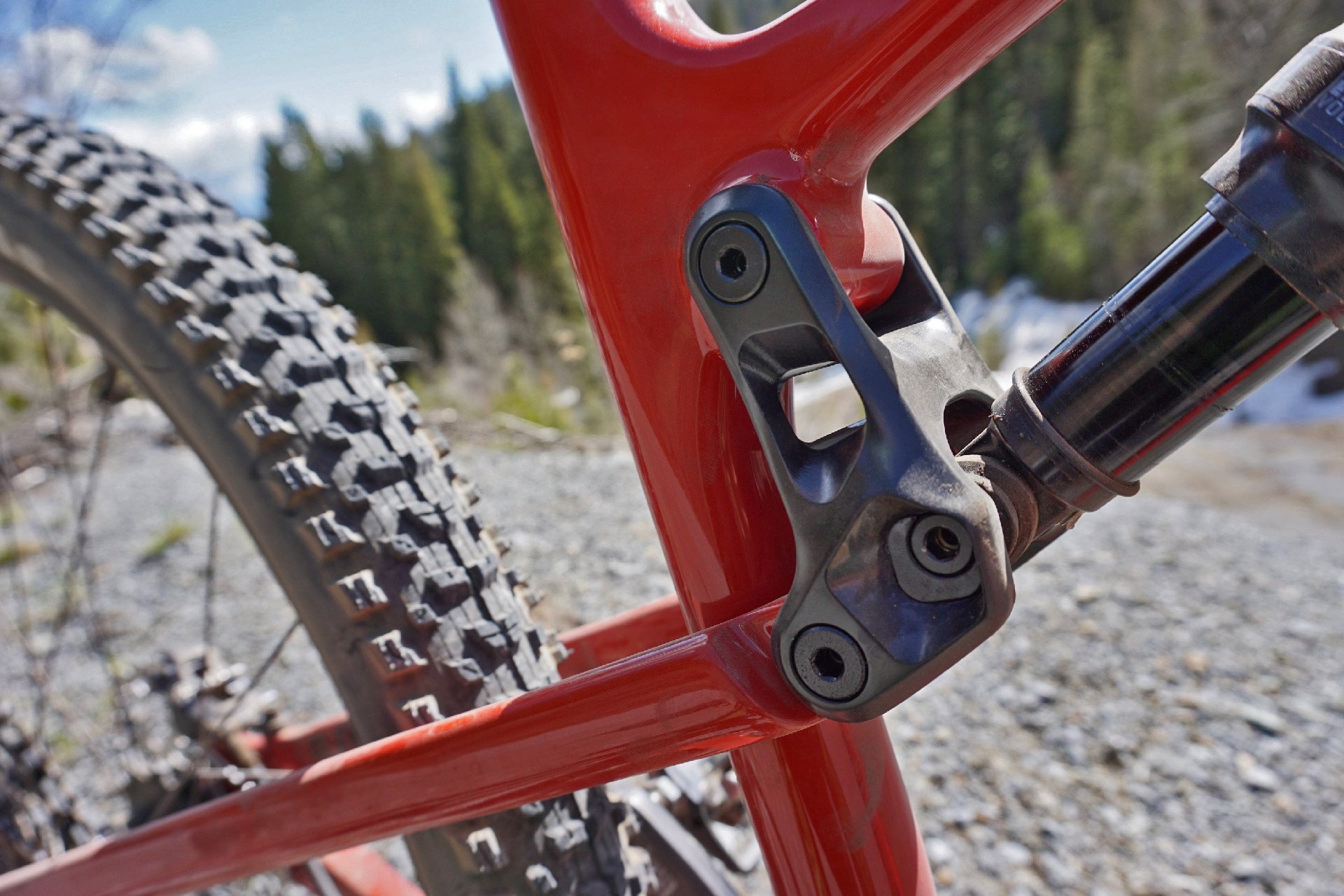
The key to a whole range of personalities - from mild-mannered to psycho - Ride-4
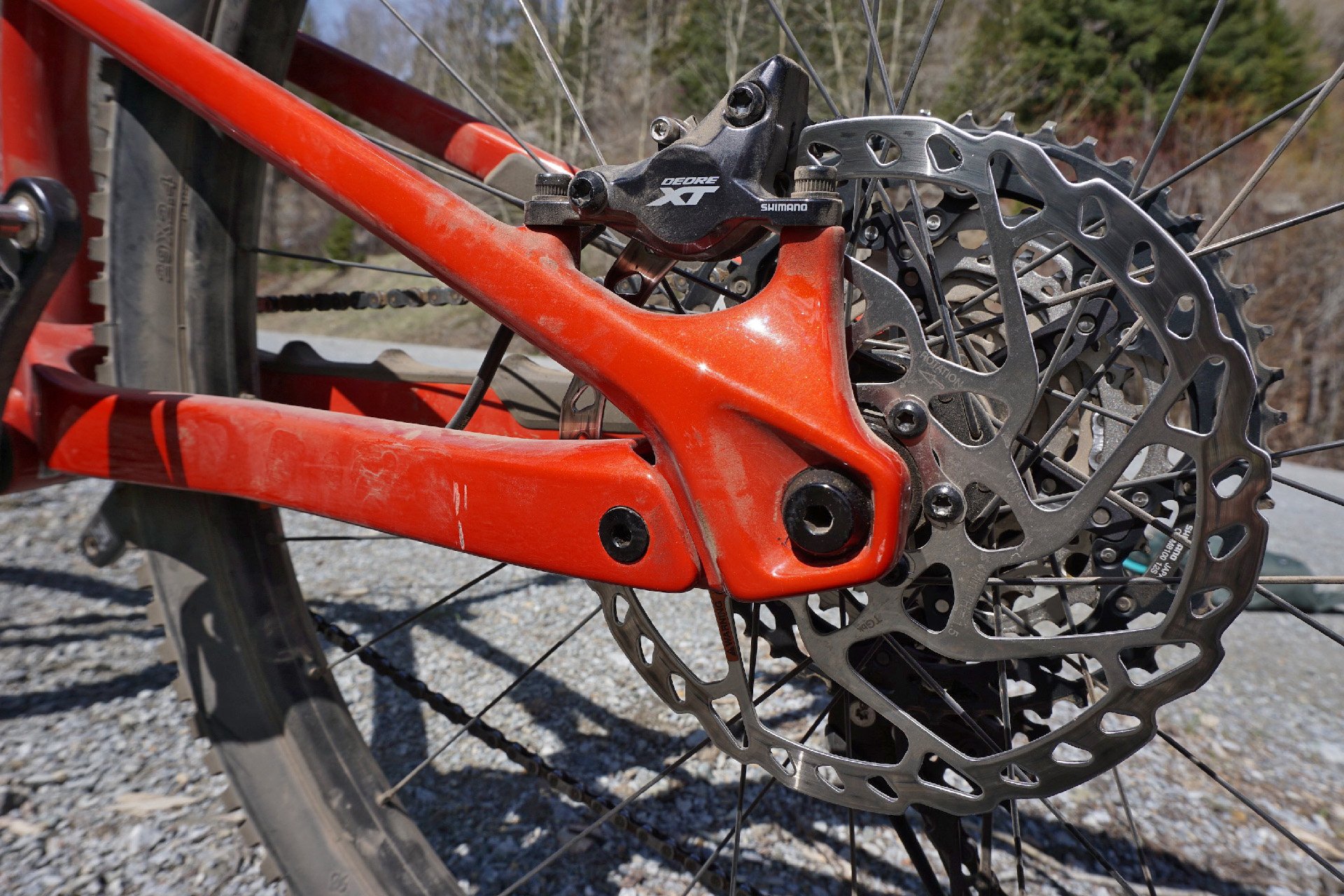
A more subtle and reserved, and super clean, implementation of the revered Horst Link
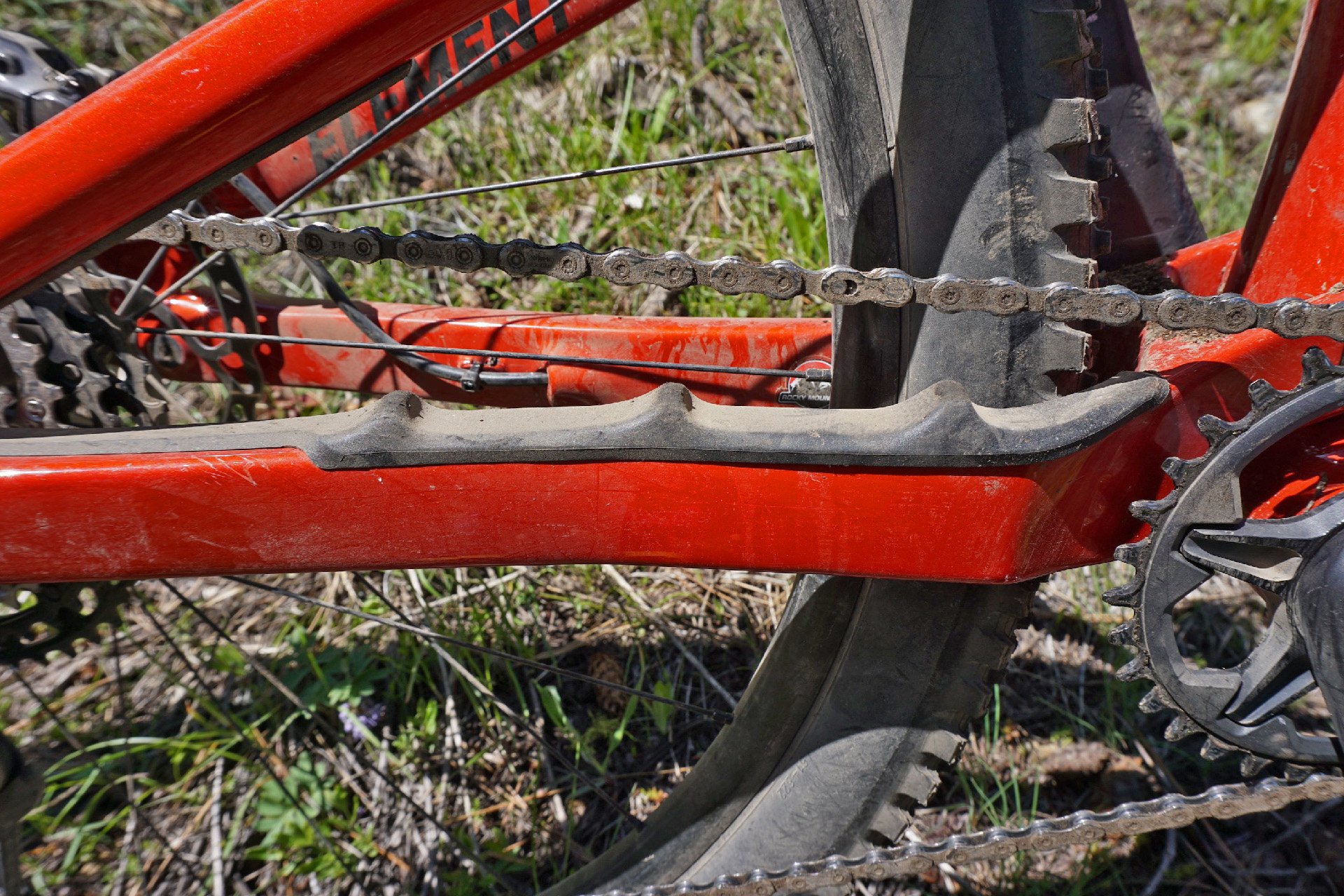
Can we all just take a moment to appreciate the radness of modern chainstay protectors? Soooo quiet!
Frame
The carbon frame is slender and adorned with nice finishing touches. There are two waterbottle mounts, praise be, with the lower being one of those three-hole affairs that gives some choice as to where you may want to mount a bottle cage or other “accessory.” The internal cable routing is sleeved and silent, and the ports allow for surprisingly easy cable and hose reroutes; being from the bottom of the world I run my rear brake on the left, and swapping the hose on the Element was one of the most painless reroutes I have ever undertaken. The rear Horst Link pivots are unobtrusively flushed into the swingarm, and the Ride-4 hardware is cleanly executed and simple to futz around if you’re into trailside ride adjustment. We’ll get into the whole Ride-4 stuff in a bit. This particular bike also comes with a 10mm cup at the bottom of the headtube. This stacks the headset a centimeter, effectively lengthening the headtube by this amount and slackening the head angle further than the numbers on the spreadsheet. At a squint, without an accurate gauge, I’d guess this probably slackens things by about .3 of a degree.
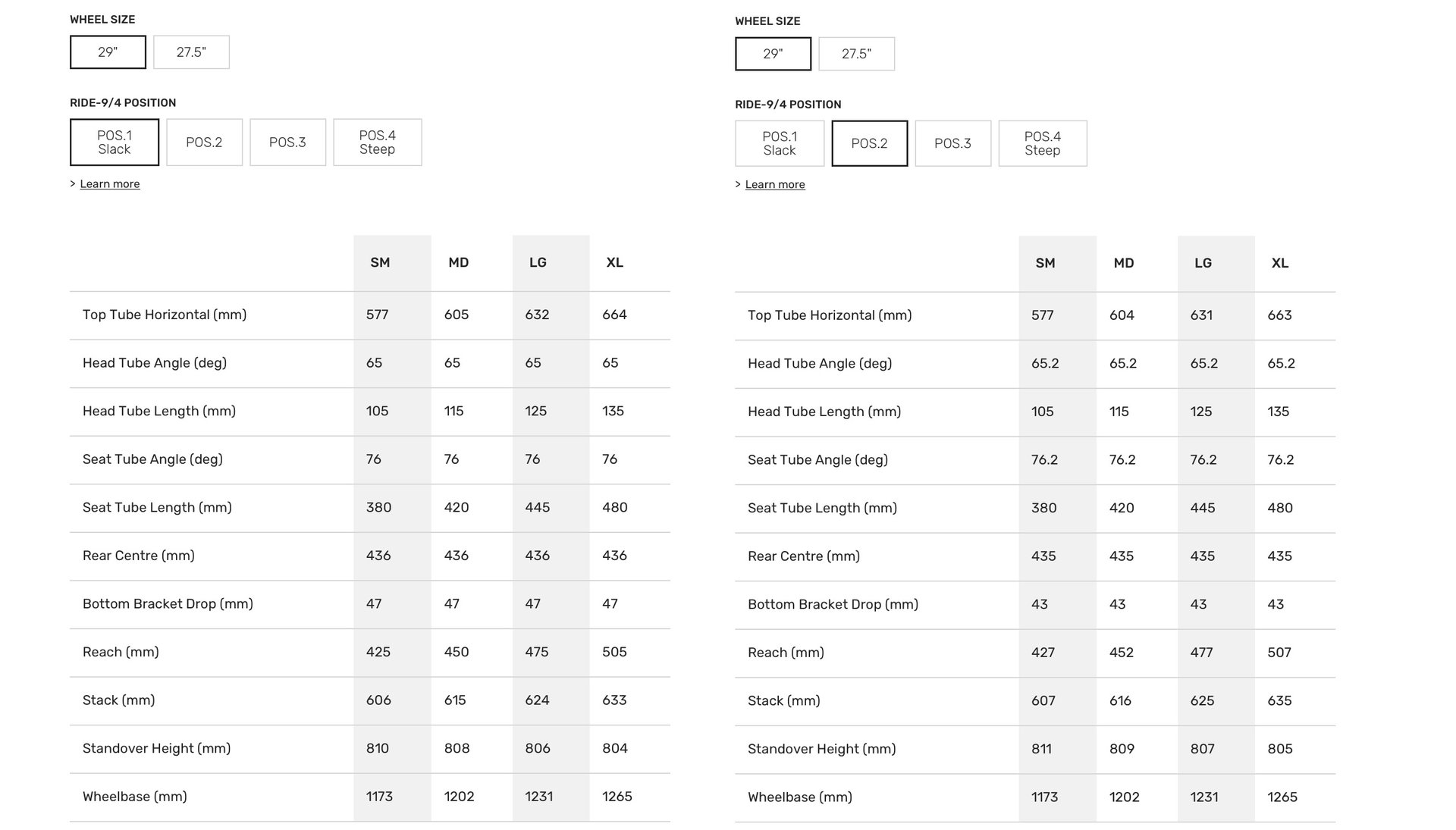
Speaking of geometry (again), here are the numbers. Above you'll find the slackest and and second slackest, portions 1 and 2.
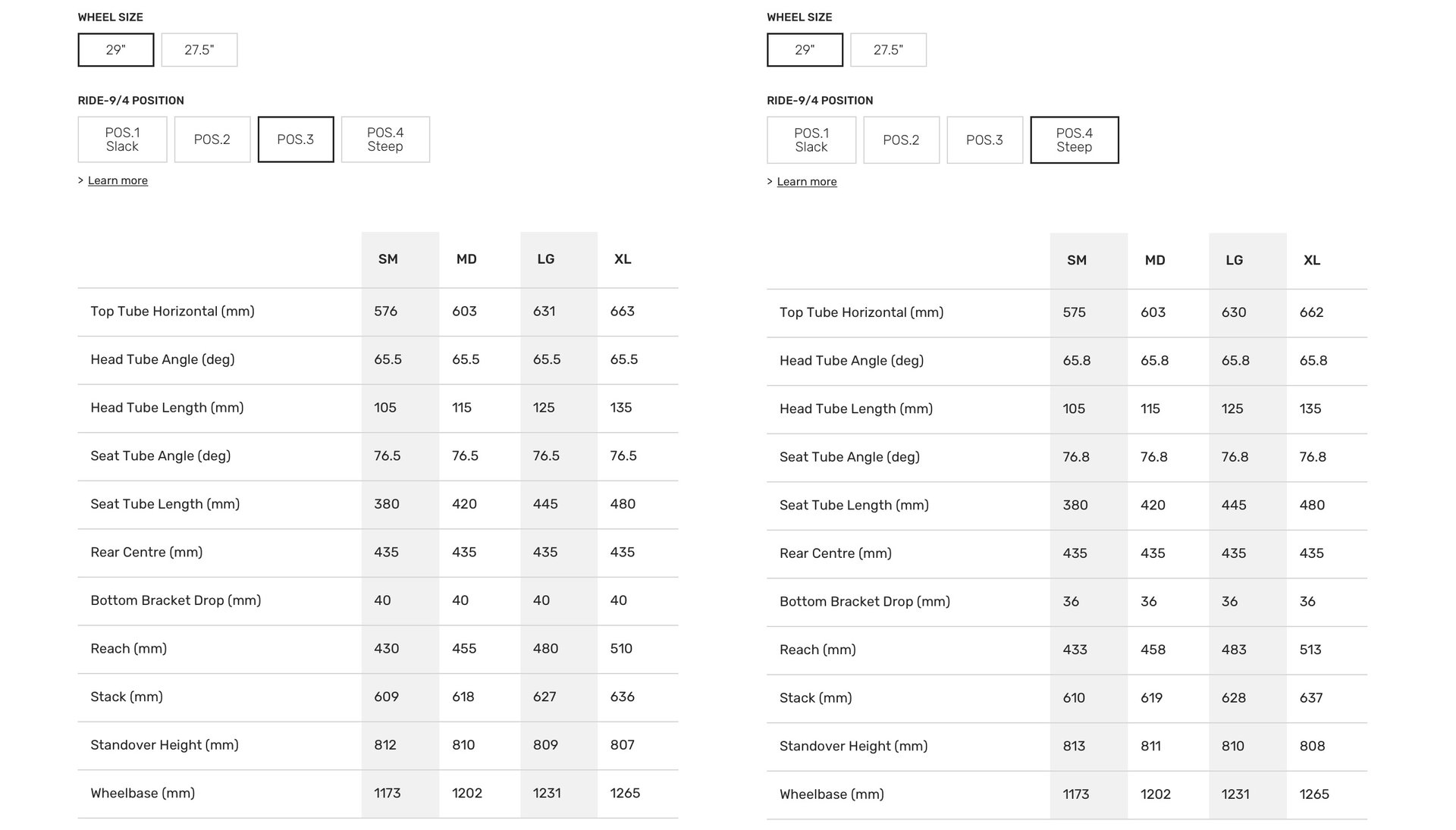
Above you'll find the 3rd slackest and the steepest, portions 3 and 4 respectively.
Ride-4 is a welcome simplification of Rocky’s previous Ride-9 adjustability. Ride-4 consists of an eccentrically bored square-ish flip-chip mounted on the rocker link at the lower shock mount that can be nested in one of four different positions. According to Rocky Mountain, “the RIDE-4 adjustment system allows riders to quickly fine-tune their geometry with a pair of Allen keys. Four configurations are possible thanks to one rotating chip. This allows for subtle geometry changes with minimal effect on your shock tune.” In the case of the Element, head angle ranges from 65 degrees in slackest setting to 65.8 in the steepest, with seat angles correspondingly shifting from 76 to 76.8 degrees. Or, in the case of Elements that come with this extra cup in the head tube, 64.7ish to 65.5ish degrees for the head angle, 75.7ish to 76.5ish for the effective seat angle. As for whether or not to expect a headset cup with a new Element purchase, hopefully I’ll have an answer for that by the time we get to the long-term review.
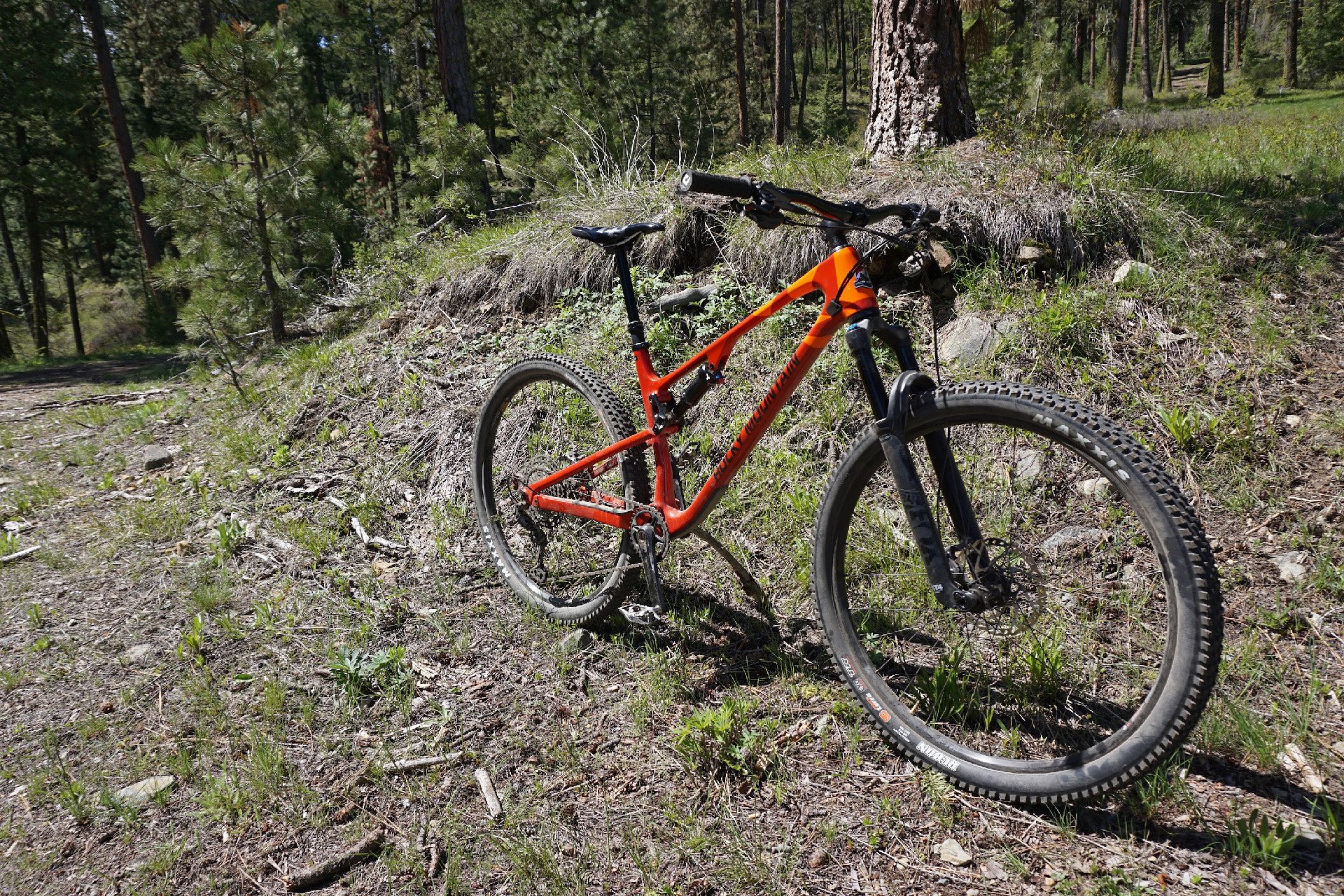
Element, in its element, after a morning of bushwhacking through a spring landscape of fine Oregonian lumber-jank
Riding Impressions
So, is this an XC race bike?
I do not know.
Its long enough and modern enough in its geometry that I suspect some traditional riders will feel like it is lazy handling and maybe even lazy accelerating, and therefore NOT an XC bike. But I also suspect there’s a lot of confirmation bias at work with some riders with regard to what feels fast versus what is actually fast. And in the case of the Element Carbon, speed is a very subjective thing.
It hauls the mail. Pedaling response is right away; it accelerates beautifully, and at the same time manages to stay more active and compliant in chunky climbing than any of the flex-stay bikes I’ve ridden lately. Seated climbing, it just motors up as fast as you can mash the pedals. The Horst Link rear end is more active than the current flex stay trend, which also means there is some degree of bob when standing and climbing, or when transitioning from seated to standing. If there’s any feeling that this equates to “slow,” I’m going to withhold judgement until I get to run some stopwatch times between this and other, conceptually sharper bikes. In almost every climbing situation I’ve been in so far, from heinous steep loose fire roads to seated wattage burners to ledgy uphill singletrack, it has been an absolute joy to pedal.
In rolling terrain and flat corners, the length of the bike becomes very apparent. This is where old school riders will feel slow. Especially old school riders who are used to hanging off the back of their steep and short bikes out of necessity. Hang off the back of the Element and kiss front end traction goodbye. This is a modern handling bike, and as such it demands that its rider stay centered and keep a lot of weight over the front. The front traction, or lack of it, isn’t exactly helped in loose terrain by the Rekon 2.4 rubber, but by the same token, these are still substantially beefier tires than most really serious leg shavers are likely to want to run if they’re pinning numbers onto their jerseys. Suffice to say that the handling is not helped by old habits. Get forward, push down on the bars, and make it turn. I think the most fitting analogy for the way the bike feels is that one tends to ride “in” this bike, rather than “on” it. This is not a criticism. However, having toggled the Ride-4 chip from full slack to full steep, the Element corners a lot more accurately and easily in the steep mode than the slack. And is still battleship stable.
As speeds increase and the ground tilts downward, the Element just flat out eats the lunch of any XC bike I’ve ever known. I’ve had a solid amount of saddle time in the past two years aboard three flex-stay bikes; an Epic Evo, a Kona Hei Hei, and a Transition Spur, and those are all on the “progressive” end of XC design. The Element is more composed, more stable, more plush, and more fun than any of the aforementioned trio. The bike has an airy feel that makes it wonderful to mash into ledgy, techy ups and downs, and it stays planted and smooth way past the point where you run first out of tires then out of suspension. And even when the suspension has clanged past its limits, the bike doesn’t feel hell bent on ejecting its pilot or snapping in half. It’s light feeling and super fun to wheelie, it can be pushed into different lines without getting too twangy, and it performs with about as much broad and capable sophistication as you can expect from any 120mm travel bike. I’m really looking forward to a summer on this bike.
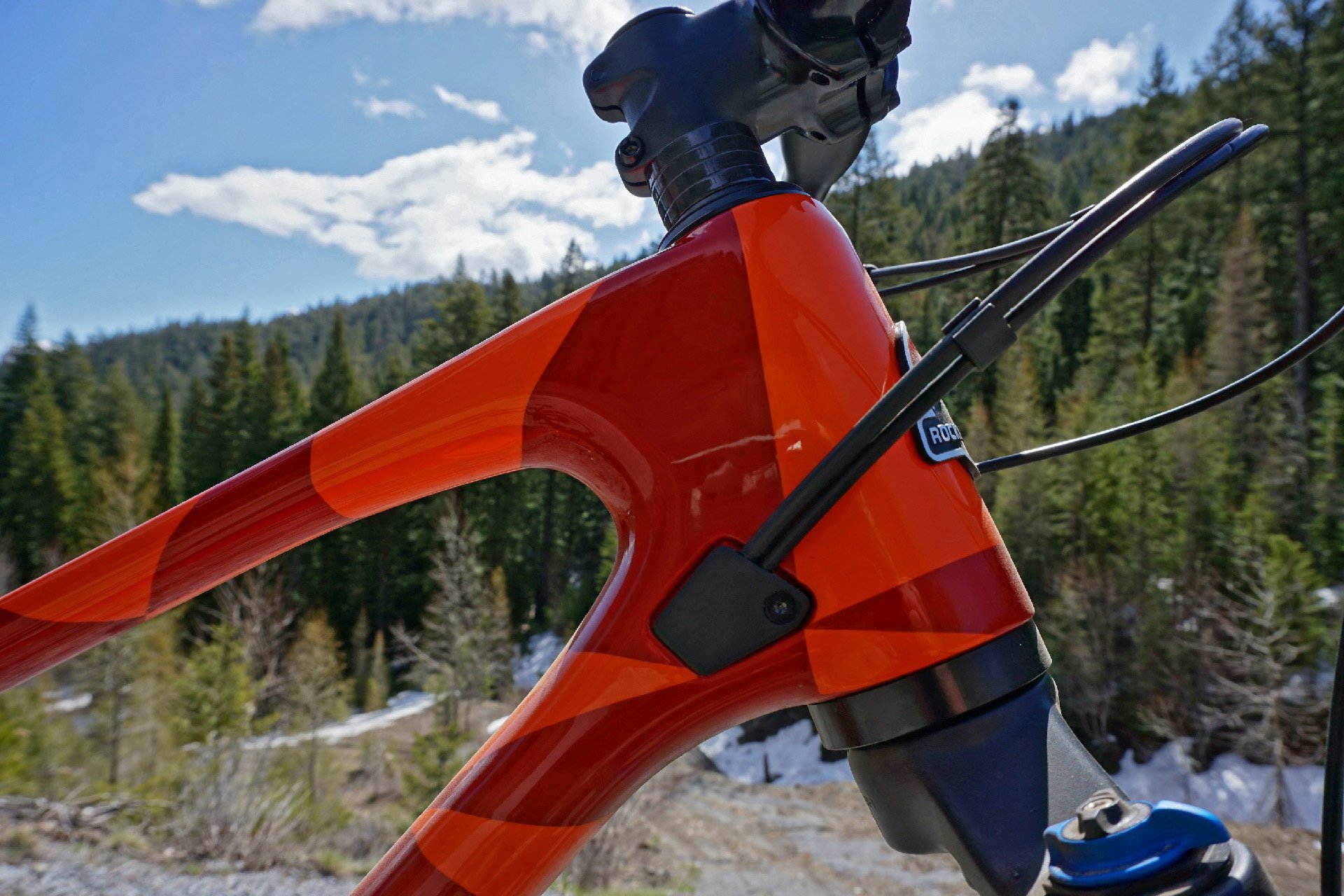
A three-part inquisition into the "not all that XC" aspect of the Element. Exhibit A: Stack. Spacer under the head tube and a pile of washers beneath the stem. This may change.
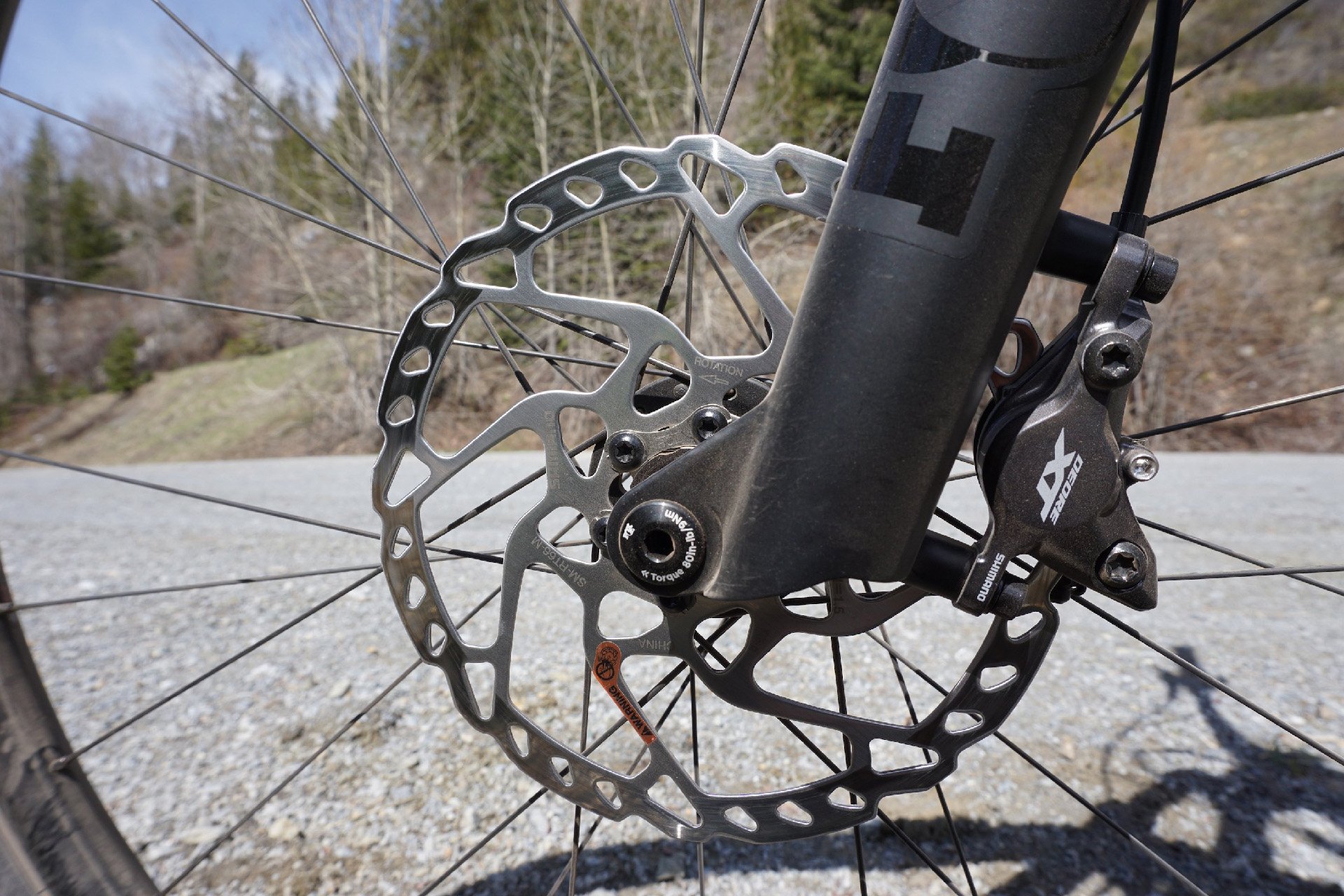
180 rotors front and rear, but 2-piston calipers. With resin pads, I suspect. This, too, may change.
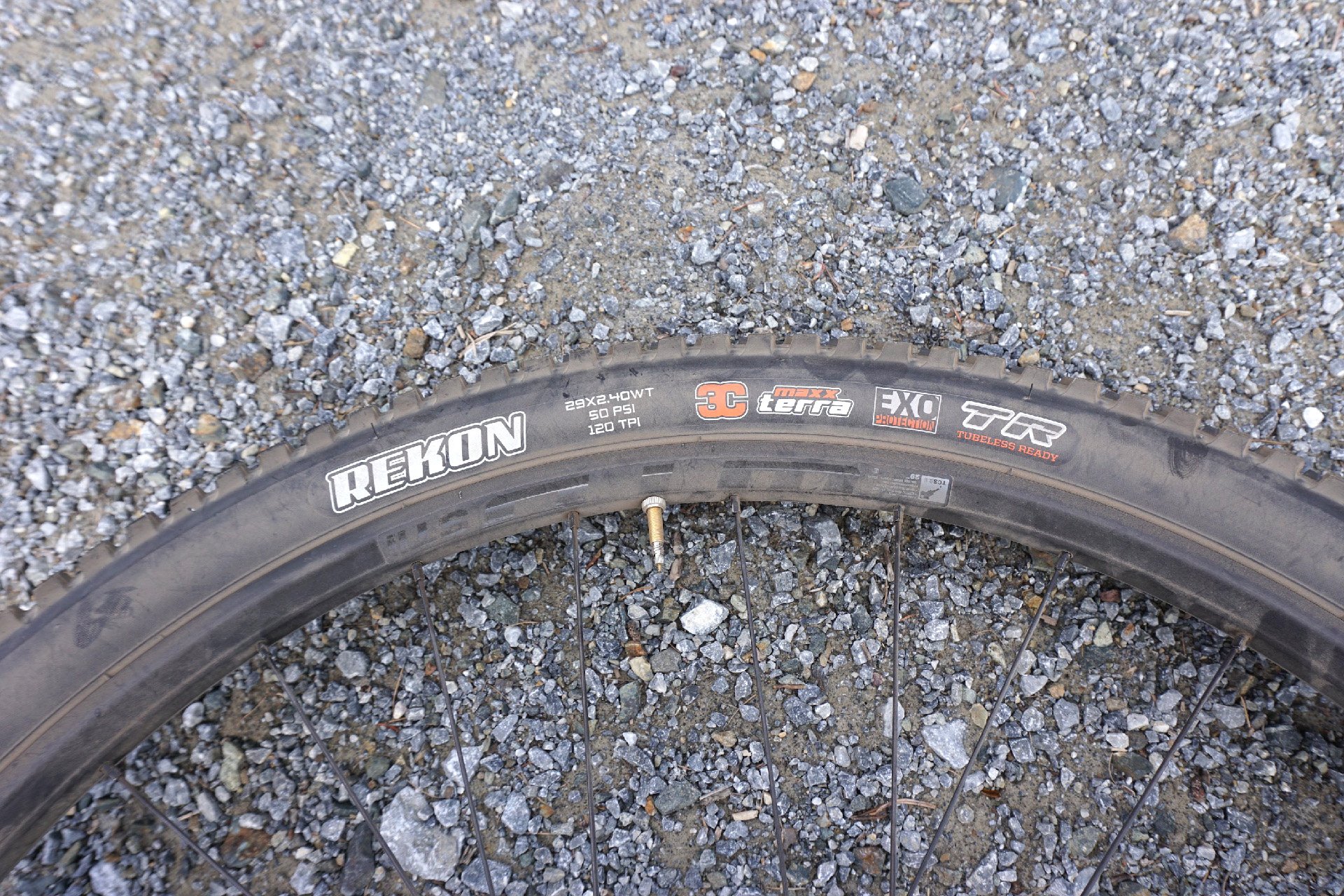
Rekon 2.4s. Hmmm, neither fish nor fowl, as far as this bike goes. Not light enough for full XC, and nowhere near meaty enough for the potential rowdiness this bike may encounter. This WILL change. Oh yes...
The Devil’s Details
Straight across the board XT built on this level, with a RaceFace dropper post and lever, RaceFace hubs laced to WTB ST Light i27 rims, and those 2.4 Rekons. Rocky Mountain bars in 760mm are maybe a nod toward XC intentions these days. The XT brakes are 2-piston units front and rear, which might be considered XC territory, except there’s a 180mm rotor at each end of the bike as well. It is, all things considered, a decent component mix that speaks to general purpose utility more than it does trying to appease either end of the bell curve.
A Fox DPS Elite shock does the business at the rear, and there’s a 130mm travel 34 performance Elite up front. The shock feels well matched to the bike’s kinematics, but heavy riders (talking those over 200 pounds here) are going to need to pump a whole lot of air into that shock to get it to play nice. I’m 190, all kitted up with backpack and ready to ride, and am running 230psi in the shock at the moment. That has the sag at about 13mm, and I think I might want to put a little more air in there. Up front, while I’ve had mixed feelings about Fit4 dampers in the past, the fork on this bike is so far feeling really, really good.
If there’s any one area I am going to futz around with, it’s going to be wheels and tires. I am curious to see how much more responsive the bike becomes by ditching the stock wheels for something really light. And at the same time, I am curious to see how it behaves by pushing the tires in either direction – either going full XC-nerd and slapping some sub-600 gram flat magnets on there, or laying in some nice 1000-ish gram low durometer, big knob meats and seeing just how rowdy things can get.
Otherwise, it’s a runner. I’ll try not to kill myself.
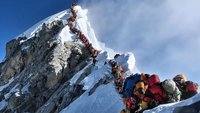
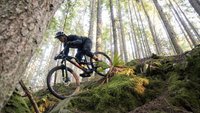

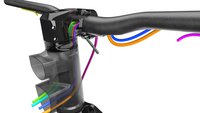







Comments
Perry Schebel
1 year, 11 months ago
i love the aesthetics of this frame; (relatively) skinny tubes are a nice counterpoint to the bloated ebike-esque forms that are prevalent these days.
Reply
d.m.
1 year, 11 months ago
This comment has been removed.
Joseph Crabtree
1 year, 11 months ago
This comment has been removed.
d.m.
1 year, 11 months ago
This comment has been removed.
d.m.
1 year, 11 months ago
This comment has been removed.
Perry Schebel
1 year, 11 months ago
i've nothing against ebikes; just observing that lots of (non-e) carbon bikes have chonky downtubes nearing battery encapsulating girth, and this is a neat juxtaposition. i harbor nostalgia for the skinny tubed steel frames of yore, and this appeals to that.
Reply
d.m.
1 year, 11 months ago
I get that. I still have a soft spot in my heart for my Ibis Tranny (as it gathers dust in the basement!).
Reply
Jan
1 year, 11 months ago
I reserved an XL Element shortly after the bike was announced and have been riding it for the better part of a month. Mike's experiences are well aligned with my observations. I truly need to make a conscious effort to ride further forward as I've lost the front wheel twice on very benign flat/uphill corners. No doubt, some of my dumbest crashes. I'm used to piloting an aircraft carrier on singletrack as my other bike is an XL G1. However, my balance needs to be recalibrated since this rear center is about 20mm less..
My Element also came with the EC lower bearing. The dealer told me I could get a free replacement in August if I wanted. I went ahead and replaced it with an in-stock ZS Wolf Tooth. The Element thread on MTBR indicates EC bearings are more frequent than not on this first(?) production run, with some folks favoring the EC to compliment 120mm SID/Cast forks.
I'm also more or less in agreement with Mike's component perspective. My front pads were metal, my rear were resin. They're both now Galfer green with 203mm rotors. I imagine 4 pistons will be inevitable. The two volume spacers in my 34 GRIP were insufficient for my 185lbs. Three in a GRIP2 are superb. Ikons were the first to go but I'm still uncertain on tire direction. Next up are Vittoria Mazzas F/R.
The bike provides exactly what I wanted. It rewards voracious climbing days with a familiar fit to my 170mm G1, but forgoes 50mm of travel in exchange for shedding, ahem, 11 lbs__. I'm not terribly concerned with weight (or a disciple of Mr. Porter), but 11 lbs is significant.
Looking forward to reading how you get along with yours, Mike.
Reply
Heathen
1 year, 11 months ago
Mine came with an FSA EC lower cup too. I swapped for a purple Wolftooth.
Reply
Alex Chan
1 year, 11 months ago
This comment has been removed.
Heathen
1 year, 11 months ago
When they dropped the new Element I knew I had to have one. Put money down in September and the bike arrived in December. It was worth the wait. For where I ride and the way that I ride it is the ultimate BCXC bike. I got the C30 and swapped ever part but the drivetrain and rear shock. Probably should have waited a bit long and bought a C50. With 30mm carbon rims, Recon 2.4 out back and DHF 2.5 up front the bike is a absolute rocket. I have done XC races, 30km epics and drops and steeps I probably shouldn't. The bike has yet to let me down.
Reply
Chad K
1 year, 11 months ago
Wow, that's a beautiful bike! Really furthers my desire to have one. If only I could figure out a place to get one here in the US. Should I get one, I imagine that I would likely emulate your setup almost exactly as it seems to be a good balance of grip and speed
Reply
Heathen
1 year, 11 months ago
Thanks. It's a blast to ride. The geo definitely makes you push it way past what you would normally consider riding on an XC bike. I had a 2018 Optic before this. The Element is way lighter and more fun. Plus I could never keep the pivots tight on the Optic. I have already racked up almost 400km and nothing has come loose or given me issues. Super well designed bike.
Reply
Kos
1 year, 11 months ago
Great topic, great bike. Looking forward to longer term thoughts!
Reply
damientheo
1 year, 10 months ago
An xc review with no weight? I thought I'd never see the day
Reply
Mike Ferrentino
1 year, 10 months ago
Ahhh, jeez, I better go weight it again. I *think* it was just about 27lbs when I first built it up, with 4oz of Orange Seal in each tire and XTR trail pedals. But I can't find my crib notes on that. Pretty sure it would be super easy to drop two pounds with tire and wheel upgrades, since the stock wheels are boat anchors. I'll probably get to that at some point, but any wheel weight loss will likely be negated by going the other direction with tires.
Reply
taprider
1 year, 11 months ago
Equally curious
and wondering if the 7cm longer front centre than the previous Element will limit the ability to use a light/fast rolling front tire
Also some racers have supposedly been using a 120mm fork without the 10mm head tube spacer. Wonder how that changes things.
Reply
skywalkdontrun
1 year, 11 months ago
I'm interested to see if the quality control issues that have plagued Rocky for the past few years have been addressed. Since about 2018 Rocky's have looked great, and ridden great out of the gate, and then seem to hit a magical wall at about 6 months/1000 miles where they just seem to fall apart. Cracked frames, snapped chainstays, bearing play, etc. I also feel like rebuilt more blown shocks coming off Elements, Thunderbolts, Instincts, and Altitudes in the last five years than any other company, but that may just be biased memory.
Reply
Justin White
1 year, 11 months ago
"This allows for subtle geometry changes with minimal effect on your shock tune"
Baloney. On Ride9, 2 outside corners are "slack/steep" and the other 2 are "more progressive/less progressive". Ride4 has only 4 "outside" corners: 1 & 4 are like 1 & 9 on Ride9, slack to steep; and 2 & 3 on Ride4 are like 3 & 7 on Ride9, more progressive to less progressive. Either Ride4 changes "shock tune" more than they want to admit, or Ride9 doesn't change it as much as they want us to think.
Reply
cheapondirt
1 year, 11 months ago
The chip does look smaller than ride-9, so the changes may be more subtle than between equivalent outside corner positions 1,3,7 and 9.
Regardless, each position will have a unique leverage ratio and progression, which should be tangible.
Reply
Andy Eunson
1 year, 11 months ago
I’m thinking if the bb was moved forward a bit while keeping the wheelbase the same and increasing the rear centre as the frame size increased would create a more balanced bike. The riders weight would be more centred descending and a slacker seat tube angle is more efficient for climbing.
Reply
Steven Hambleton
1 year, 11 months ago
BB92 bottom bracket...
And I wish they wouldn't spec frame only options with a top of the line shock, some of aren't made of money!
Reply
Timer
1 year, 11 months ago
Does Rocky even sponsor a XC pro team anymore?
I'm not sure if there is even a need for the Element to be XC race capable. There are enough other bikes out there with more aggressive XC geo.
Reply
Jeremy Hiebert
1 year, 11 months ago
This bike looks like so much fun. I tried a 2021 Altitude last year, and although it was ridiculously plush and so fast on the steepest descents, it just seemed like a bit much as a regular bike. I bet this Element would be perfect.
Reply
Fahzure
1 year, 11 months ago
Mmmm, "big knob meats and seeing just how rowdy things can get." The best ROI on extra weight is meatstick tires, maybe with inserts.
Reply
Martin
1 year, 11 months ago
One detail that I have spotted is the fact that this Element's Shimano RT66 rotors look different than mine. The ones shown here seem stamped instead of machined like the 5-6 RT66s I have here. Plus, they sport the CHINA word on them instead of JAPAN on all of mine.
I guess Shimano is also trying to save some money and/or diversify its production locations, but if they're really stamped instead of machined (it seems so because the cutouts and edges seem rounded) , I'd expect a performance downgrade vs the "original" ones. I used to recommend those rotors to people who had "resin only" rotors and wanted a cheap upgrade, but then I might need to recommend something else now.
Did I see this right or if it's a lighting illuson?
Reply
Taiki
1 year, 11 months ago
Your eyes aren't playing tricks on you, last year I got a new set of RT66s and for the life of me could not get them to bed in properly and deliver the bite I was accustomed to. I looked closer and compared to a NOS RT66 I had, and noted the newer one was marked Malaysia instead of Japan. I also noticed the Malaysia rotor was stamped with the rounded edges and had a much shinier finish (entire rotor, not just braking surface) compared to the dull flat finish on the Japan rotor.
Even after trying various pad materials/makes along repeated cleaning and sanding, I could never get them to work as well as the old RT66s
Reply
Martin
1 year, 10 months ago
Thanks for your feedback! I have asked a friend whom I had just recommended to get RT66s and he confirmed that they were stamped and made in China. Having known they would be different, I'd have told him to get some other rotors. Unfortunately, it's a sign of the times.
Reply
Lynx .
1 year, 10 months ago
Mike, loving your new TRAIL bike, look forward to hearing your longer term thoughts on it. As to the tyres, I think they provide a good starting place that you can easily add a more or less aggressive tyre to go either way in how much grip and more or less aggressive you want it to have - Add a Rekon RACE to the back with the Rekon front and you have a "laymans" "XC" setup, add a DHF to the front with the Rekon rear and there you go, a really nice, but fast Trail/Aggro Trail setup.
As to the lower headset cup, I'd say closer to 0.4 degree change in HTA and cheap and easy enough to swap to a IS if you don't like it that slack, heck, keep it for Trail riding and then if you're doing an XC race or something, throw in the IS to steepen things up a bit for tighter courses.
Guessing that while I think you'll run the stock setup brake wise for a bit, that sooner, rather than later you'll at least swap the front caliper to the 4 piston version and maybe a 203 rotor.
Reply
Heathen
1 year, 10 months ago
That's what I did to mine. DHF 2.5WT up front. Recon 2.4WT out back. Level ultimate levers with a code caliper up front and guide caliper out back. Huge upgrade.
Reply
JL Robichaud
1 year, 9 months ago
I just built a frame up with some light components. Got er down to 23.5 #'s. Almost as capable as my revel rascal but flies thru the singletrack and uphill so much faster.Still getting used to the ultra steep st angle though. Feels sluggish on false flats.
Reply
Chase Moreira
1 year, 8 months ago
Hey JL - mind sharing a bit about your build spec to get it to that weight? Looks like a sc fork? Did you stay 2 pot brakes? Drive train? Thanks!
Reply
Justin White
1 year, 11 months ago
"As for whether or not to expect a headset cup with a new Element purchase, hopefully I’ll have an answer for that by the time we get to the long-term review."
That is super odd. Yeah, hopefully you'll get an answer for that. Though it does point to a bit of an internal disconnect around geometry over there. Kind of like how the last Altitude came out as the new "enduro bike", but most (all?) of the enduro team put anglesets in. Allegedly only temporarily to "make it feel like the last bike" (Slayer?"), but pretty sure they stayed in all last season.
Reply
Cooper Quinn
1 year, 11 months ago
I'd suggest the geometry needs of Jesse, Remi, and ALN are different than 99.99% of riders.
Ritchie Rude was (who knows, maybe he still is) "as much pressure as Fox will let him" in his fork. His setup (or Jesse's, or Remi's, or ALN's) just isn't actually that relevant to most folks. Ritchie was also winning races on a bike that the internet probably thought was so out of date it should be in a dumpster.
Honestly its weird to me that customers/riders obsess so much about what people are racing on... I'm not out there changing tires on my truck because someone won King of the Hammers on a set of whatevers - and I don't think dropping 129g or saving 2.5W on my drop bar bike is making the difference between me and a pro tour ride. The needs of us mortals and the needs of those at the top of (any) sport just aren't the same.
Reply
delta5
1 year, 11 months ago
Their needs may be different, but weird anecdote:
I was having trouble finding a comfortable and balanced setup with the Fox 36 on my Tracer 275. In the midst of playing around, I tried Richie's settings just to see how "wild and out there" that extreme a setup is. Turns out it was absolutely perfect for me. Suddenly carried much more speed, and the bike was far more responsive. In no universe am I a pro level rider, and would hesitate to even call myself an amateur. I'm a hack, I'm slow, and I'm aggressive through the rocks. It makes no sense that Richie's setup would work better for me than anything else, especially the silly pressures he runs.
Since then, I've been paying much closer attention to what the enduro pros run because their settings just work for me, far more so than whatever manufacturers recommend as a baseline. Because of that, I also pay closer attention than before to what equipment they're running.
Reply
Heathen
1 year, 11 months ago
What is this suspension setup you speak of?
Reply
Cooper Quinn
1 year, 11 months ago
Bear in mind he's likely running completely different shim stacks and tunes internally though... so "XX clicks of LSCR" on his fork... isn't the same as yours. Same fluids? Same seals? I'd also bet he's a couple clicks one way or the other on most settings, and different pressures, in different locations and track types.
Are you the same weight/height?
All this to say... yes, maybe it works for you in this case, but there's a lot of factors at play beyond reading what pros are running.
Reply
MTBer
1 year, 11 months ago
This comment has been removed.
MTBer
1 year, 11 months ago
The bike can run 120 to 140mm fork.. The headset cup give you more room for geometry adjusting. You can use this cup or not.
Reply
Lynx .
1 year, 11 months ago
This comment has been removed.
Please log in to leave a comment.